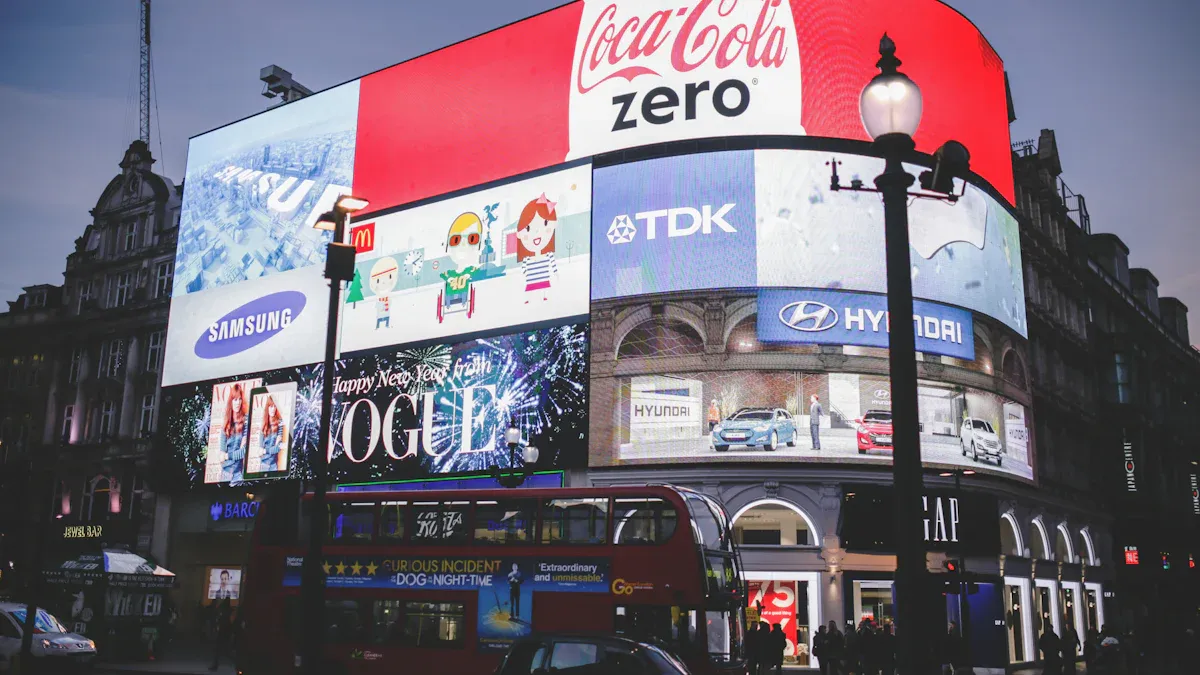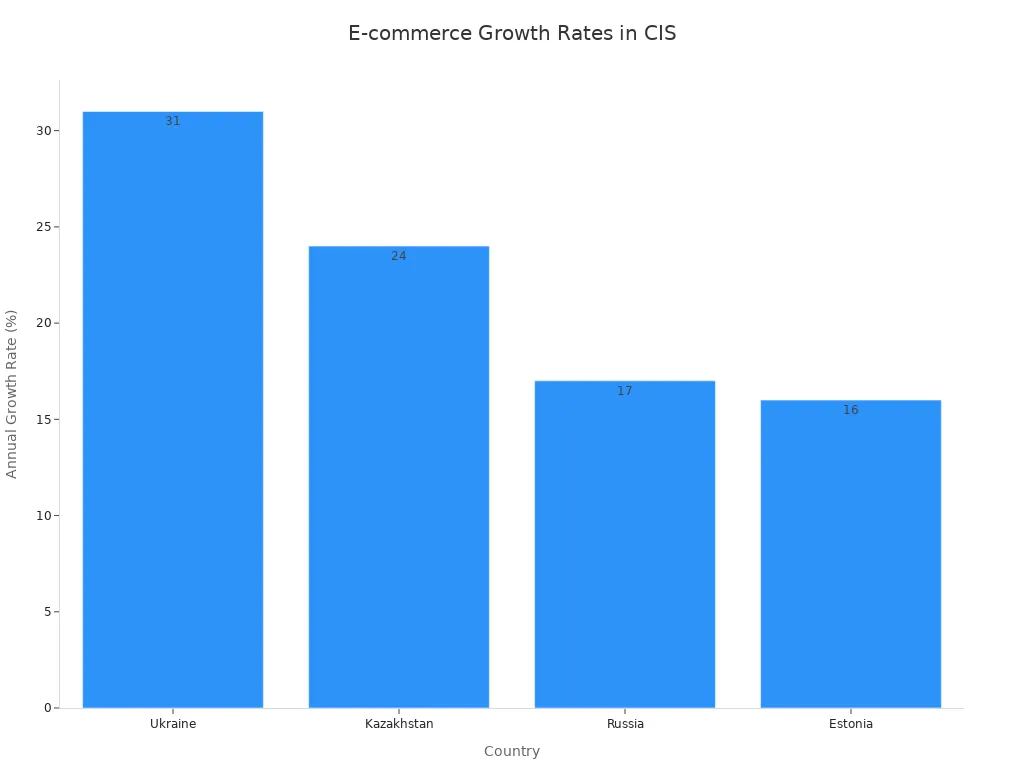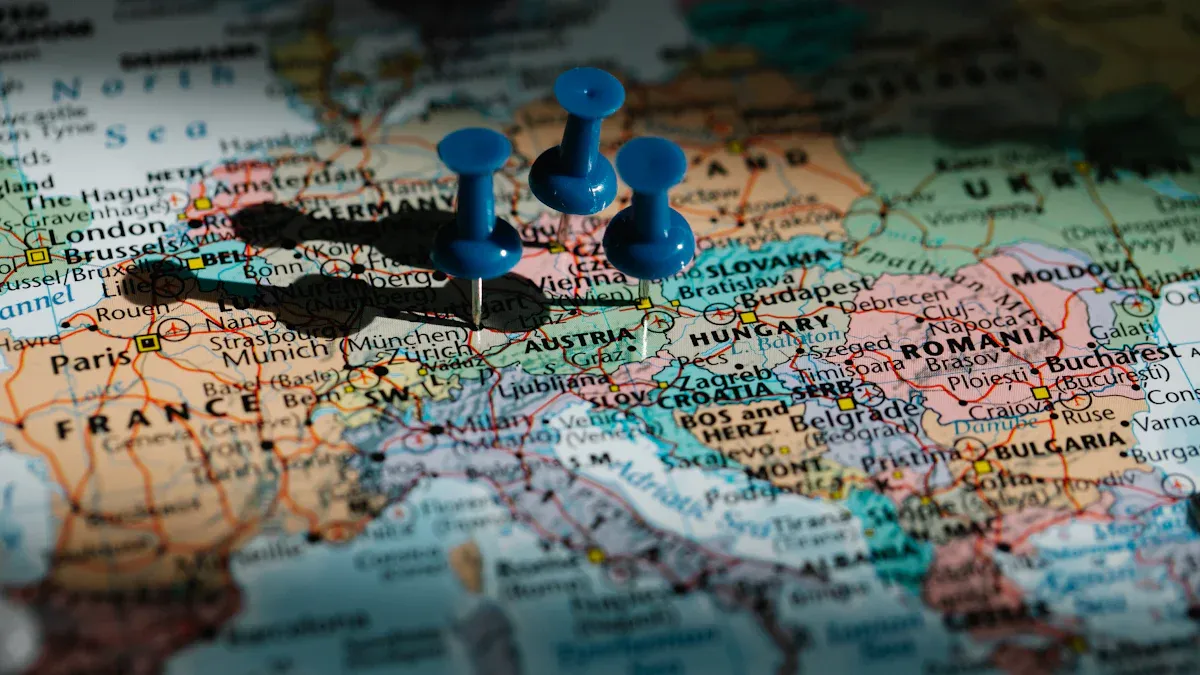
The advertising market in CIS countries is projected to reach nearly US$12.95 billion by 2025, growing at a rate of 6%. Businesses are quickly capitalizing on advertising opportunities in CIS countries by creating ads that feel personal and engaging while reflecting local culture. Social media, user-generated content, and visual storytelling enable brands to connect deeply with audiences, especially young people who are passionate about social issues. Companies that embrace these trends discover innovative advertising opportunities in CIS countries and gain a competitive edge.
Economic and geopolitical factors influence how companies strategize their advertising efforts.
Factor
Impact on Advertising
Economic Trends
Adjust budgets and encourage new ideas and ESG initiatives.
Geopolitics
Create market instability requiring greater flexibility.
Key Takeaways
The advertising market in CIS countries is growing quickly. Digital ads are the most popular and will reach almost $13 billion by 2025. Brands do well when they make ads that match local languages, cultures, and values. They use local experts to help and avoid mistakes. Social media, video, and mobile ads work best. These ads do well on Instagram, TikTok, and YouTube. Programmatic advertising and smart data tools help brands find the right people. These tools also help make campaigns better. It is important to follow privacy laws and rules. This keeps user trust and helps brands avoid fines when trying new advertising ideas.
Market Overview

Ad Spend Growth
The advertising market in CIS countries is getting bigger. Digital ads are growing the fastest. In 2025, search ads will reach about US$3.95 billion. This is a 10.1% rise from last year. More people use digital tools now. Young people like ads made just for them. Local search engines, like Yandex in Russia, are important. Live streaming ads will make US$576.19 million in 2025. This part of the market will grow by 9.79% each year until 2029.
Economic and political changes affect ad spending. When oil prices go up in Kazakhstan, people spend more money. Better internet in Russia helps digital ads grow. Ukraine’s online shopping grows fast. People there have more money and want more choices. The table below shows which CIS markets are growing fastest and why:
Country | E-commerce Growth Rate | E-commerce Market Size | Key Contributing Factors | Impact on Ad Spend Growth |
|---|---|---|---|---|
Ukraine | 31% annually | $5.1 billion | Consumer prosperity, wider product range, 25% cross-border shopping | High e-commerce growth drives increased digital ad spend |
Kazakhstan | 24% annually | $800 million | Higher oil prices, 50% exports oil, better product choices | Economic growth and consumer demand fuel ad spend growth |
Russia | 17% annually | $32.55 billion | Improved internet access, better delivery systems, 62% cross-border shoppers | Infrastructure improvements stimulate digital ad growth |
Estonia | 16% annually | $270 million | 62% cross-border shopping, e-commerce is 6% of retail sales | High cross-border shopping supports ad spend growth |

Digital Shift
CIS countries are using less traditional ads now. They are choosing digital ads instead. Many things cause this change:
More people watch digital content and use new tech. Young people like this the most.
Social media helps people connect and share their culture.
Marketers use digital ads and local content to reach more people.
Each country is different: Russia has strong digital tools, Kazakhstan uses two languages in media, Uzbekistan supports new ideas, and Belarus has both state and private media.
Better internet, more phones, and growing economies make digital ads grow faster.
This change makes the market exciting. Brands must change fast to keep up.
Advertising Opportunities in CIS Countries
Digital and Programmatic
Digital and programmatic advertising are changing how brands reach people in the CIS region. Marketers use smart platforms to buy ads and improve campaigns quickly. Some programmatic platforms are now very popular with advertisers in these countries. The table below shows important platforms and what they offer:
Platform | Key Features & Ad Formats | Presence & Traction in CIS Countries |
|---|---|---|
Galaksion | Push notifications, native ads, direct links, interstitial, on-page notifications | High traffic, diverse formats, quality traffic |
Eskimi | Full-stack DSP, rich media, video ads, telco-level targeting, 2,500+ segments | Specialized in CIS, strong local targeting, campaign optimization |
Smarty Ads | SSP and DSP, banners, video, rich media, native ads, advanced targeting | Diverse ad formats, suitable for CIS advertisers |
PropellerAds | Push notifications, popunder, interstitial, survey exit, automated optimization | Popular for finance, utilities, lead generation |
RichAds | Telegram ads, push, popunder, native, display | Cost-effective, large traffic in CIS |
NT Technology | Local platform, aggregates online advertising solutions | Regional traction, based in Belarus |
NT Technology is from Belarus and shows local programmatic tools are growing. Eskimi is known for its smart targeting and local skills, helping brands find the right people. These platforms give advertisers new ways to try advertising in CIS countries and get better results.
Social Media & Influencers
Social media is now very important for brands wanting to advertise in CIS countries. In 2025, Instagram, YouTube, and TikTok are the top choices, especially in Central Asia. More than 90% of people in Kazakhstan and Uzbekistan use the internet, and Kyrgyzstan and Tajikistan are catching up fast. Brands work with influencers who have at least 50,000 followers, often speaking Russian or Kazakh. Influencer marketing uses Instagram posts, Reels, YouTube videos, and TikTok challenges to reach people.
Brands that team up with local influencers make real content and earn trust from buyers.
These platforms help brands connect with young, tech-smart users. Social media advertising in CIS countries keeps growing as more people join and want content that fits their culture.
Video & Mobile
Video and mobile ads are now the most popular in the region. Animation videos for learning, product explainers, and visual stories get lots of attention. For example, animation videos that show how devices work can get three times more viewers. Short videos made for phones do best on TikTok, while professional videos are good for LinkedIn. Brands use strong images, clear logos, and styles made for each platform to stand out.
Mobile-first plans are very important. Most people use smartphones, so vertical videos and short clips work well. These trends give brands new ways to reach people in CIS countries wherever they are.
E-commerce Ads
E-commerce ads are changing fast. Young shoppers want ads that feel personal and products that are special. Local brands that show cultural identity are getting more popular, especially when influencers talk about them on social media. Here are some key trends:
Personal shopping experiences bring in younger buyers.
Local brands and influencers help build community.
City and country differences in Russia, tech-loving youth in Kazakhstan, and a growing middle class in Azerbaijan shape what people want.
New rules in Uzbekistan help with trade between countries.
Big things like better digital tools and how people spend money affect growth.
Top e-commerce sites include Amazon, JD, Taobao, Tmall, Apple, and Walmart.
Social media is very important for marketing and live shopping.
Good e-commerce ad plans focus on local needs and making things easy. The table below shows important points:
Strategy Aspect | Description |
|---|---|
Dominance of Yandex | 61% market share in Russia’s search marketing; requires unique SEO and PPC optimization |
Unique Yandex Algorithms | Understanding Yandex’s features is vital for campaign success |
Importance of SEO | On-site optimization and Yandex webmaster tools boost organic ranking |
Local Social Platforms | VKontakte and Odnoklassniki are essential for reaching CIS consumers |
Language Localization | Low English proficiency (6-8%) means full localization is necessary |
Brands should make websites local, offer payment methods people like, and focus on good prices. YouTube is still a top place for digital ads. These steps help brands find more advertising chances in CIS countries.
Privacy & Regulation
Privacy rules are changing how brands do digital ads. New laws say brands must get user consent for data use and keep data safe. The table below lists new rules:
Country | New or Updated Privacy Regulation Impacting Digital Advertising | Key Provisions Relevant to Digital Advertising |
|---|---|---|
Uzbekistan | Draft Law on Advertising (May 2021) | User consent for data processing, mobile network advances |
Kazakhstan | Draft amendments to Data Protection Law (April 2021) | Notification, user consent, right to erasure, security |
Ukraine | Law on Personal Data Protection (2010) | User consent, data processing obligations |
Armenia | Law on Protection of Personal Data (2016) | User consent, data processing obligations |
Azerbaijan | Law on Personal Information (2010) | Prior user consent for personal/sensitive data |
Note: Brands must keep up with privacy laws to avoid fines and keep trust.
Following these rules is very important. Marketers who follow new laws can still find advertising chances in CIS countries and keep user data safe.
Country Highlights

Russia
Brands in Russia use AI and machine learning. These tools help them make ads personal. Programmatic advertising helps reach the right people. More people use smartphones, so mobile and video ads grow fast. Yandex, VKontakte, and Odnoklassniki are the top local platforms. These sites have content that matches Russian culture. This keeps users interested. The government helps with digital growth. This makes it easier for new technology to spread. New ways to make money, like performance ads and subscriptions, bring in advertisers.
There are some problems. Geopolitical tensions and sanctions make things hard. These issues can break supply chains and make things cost more. Brands must follow strict data privacy rules. They need to use first-party data to keep trust.
Kazakhstan
Kazakhstan’s ad market changes quickly because of digital growth. Social media like Instagram, TikTok, Facebook, Vk.com, and OK.ru are important. These sites help brands talk to people. eCommerce grows about 25% each year. Companies like Technodom, Kaspi, and Lamoda KZ lead this growth. Digital banking and fintech, like the Digital Tenge, give new chances for ads. The economy is moving from oil and gas to new areas. These include renewable energy, farming, factories, and tech. These areas get more money and offer new ad chances. Young people like real content and short videos. Brands do well by using influencers and showing Kazakh culture.
Ukraine
People in Ukraine care more about price now. This is because of inflation and money worries. Brands have fewer buyers and more rivals. They work harder to keep customers. Online stores add more products to get and keep shoppers. Real stories and clear messages matter most to buyers. Price is often more important than brand name.
Key Trend | Description |
|---|---|
More people use smartphones, so brands use mobile-first ad strategies. | |
Cultural Diversity | Ads appear in both Ukrainian and Russian to reach all audiences. |
Data Privacy | New rules require clear and honest advertising practices. |
Cross-Channel Engagement | Brands connect with customers on many platforms to boost loyalty. |
Uzbekistan
Programmatic ads on mobile work well as more people use smartphones. By 2025, 77% will have smartphones. Most people are young and know a lot about tech. Over half are under 25 years old. Some social media sites have limits. But programmatic ads still reach many people for less money. Most devices use Russian language settings. This helps with ad targeting. Main channels are mobile apps, social media (where allowed), and automated ad platforms. Media eCommerce will make about US$18.31 million in 2025. It will keep growing. Local content and influencer deals bring in young people. Government changes and better digital tools help the ad market grow.
Actionable Strategies
Localization
Brands do well in CIS countries when they do more than just translate. They change ads to fit local culture, language, and habits. Big companies like McDonald’s and KFC succeed by making products and ads for local tastes. If brands ignore culture, they can make mistakes. For example, some global brands have had problems with bad translations. Local partners and experts help brands avoid these mistakes and follow the rules.
Use the main language for ads. In Kazakhstan, ads in Kazakh get 70% more clicks than Russian ones.
Show respect for local values and holidays. Ads about Nauryz or New Year gifts in Russia work well.
Follow the rules for ads. Russia needs special labels and warnings on ads.
Ask local experts to check ads. This helps make sure ads fit the culture and avoid big mistakes.
Good local ads cost less and get more people interested.
Cross-Border Campaigns
Different cultures and languages affect how ads work in CIS countries. People like real ads and trust small influencers more than famous people. Using local language and culture in ads helps people trust brands. In Russia, local influencers on YouTube and TikTok help brands. In Kazakhstan, ads show national pride. In Uzbekistan, young people want new and fun ads. Azerbaijan mixes Eastern and Western styles, so brands work with many partners. Brands that change their ads and influencers for each country do better.
Tech & Data
Advertisers in CIS countries use new tech and data to make ads better. Tools like IQVIA’s Information Management help brands use data, learn about people, and make ads personal. AI tools help brands find the right people and get better results. The IT market is growing, with more cloud and cybersecurity. This helps brands save money and grow. Brands that use these tools can make ads work better and make smarter choices.
Compliance
Advertisers have to follow many rules in CIS countries. The rules change a lot, and many brands work in more than one country. Brands need to manage risks early. Tools like SPARK-Interfax help brands find hidden problems, watch partners, and follow the rules. The table below shows common problems and ways to fix them:
Compliance Challenge | Impact | Solution |
|---|---|---|
Data accuracy issues | Audit delays, higher costs | |
Poor data synchronization | Inaccurate compliance reports | Automate data processes |
Low asset coverage | Security and financial risks | Continuous inventory management |
Complex IT tools | Inefficient audits | Adopt modern, automated ETM platforms |
Following the rules keeps brands safe from fines and bad reputations.
Advertising in CIS countries will grow in 2025. Brands will use more digital, programmatic, and e-commerce ads. Companies that make local ads and use smart data tools do better. To stay ahead, businesses should:
Teach workers and use machines to follow rules.
Keep testing and making plans better.
Teams working together and quick alerts help brands stay ready.
Watching the market often helps brands act fast and find new chances to grow.
FAQ
What digital ad formats work best in CIS countries?
Video ads and mobile ads work best here. Short videos on TikTok and Instagram get lots of likes. Interactive ads and native content also get attention. Marketers pick ad types that fit how people use their devices.
How important is localization for advertising success?
Localization is very important. Brands change language, pictures, and culture in ads. This helps them connect with people better. Local ads make people trust brands more. Companies often work with local experts to make sure ads fit.
Which social media platforms dominate in the CIS region?
VK, Odnoklassniki, Instagram, and TikTok have many users. YouTube is still popular for watching videos. Marketers pick platforms based on country and who they want to reach. Each site has special tools to help brands find buyers.
What are the main privacy regulations affecting digital ads?
CIS countries have strong privacy laws. Marketers must ask users before using their data. Each country has its own rules. Brands that follow these laws do not get fined and keep trust.
How can brands measure ad campaign success in CIS countries?
Brands use tools to check clicks, views, and sales. They watch how many people like or share ads. Companies set goals before starting ads. Reports help brands make ads better next time.
